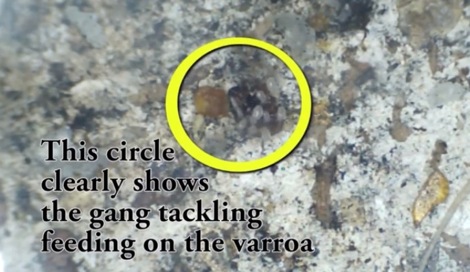Stratiolaelaps scimitus (formerly Hypoaspis miles) a possible predator of varroa?
Many years ago, Dr. David Gillespie an entomologist with of Agriculture Canada, discovered a leaf litter dwelling generalist predatory mite, which is also a native UK mite, that feeds upon springtails, nematodes, spider mites and other small insects. A Canadian company, Applied Bio-nomics Ltd, (who also ship to a European agent) were the first company in the world to mass breed it. They have been used by their customers as a successful biological for: fungus gnats, thrips pupae, pathogenic nematodes, spring tails, strawberry root weevil, root mealybugs, cactus root weevil, 2 spotted spider mites, cricket mites that affect tarantulas, pest mites in snake cages, mites that affect hermit crabs along with other soft bodied pests. Its potential is now being used against the honey bee pest, the varroa destructor mite.
Of course this is the very early stages of a potential biological control for varroa mites. In this video you can see the predatory mites tackling a varroa mite. You can watch a presentation about the predatory mite and its effects on honey bees in preliminary trials. I am aware that the Devon Beekeepers Association mention “The Chicken Vet” using the mites to control varroa and observing the results, page 32.
This has potential here in the UK, not only for honey bees. Stratiolaelaps scimitus is readily available and is a native species! So come on your researchers, a great opportunity here! I do have more information re this topic.
Personally I am thinking that they are effective predators of soft bodied mites and soft bodied immature prey. I do not know if this predatory mite has a piercing mouth part and/or a pair of mandibles capable of tearing open hard bodied prey items. I also do not know whether the adult varroa mite has a hard external body. If it does and can only be attacked from underneath where it may be softer or have areas where the predator can pierce, its effectiveness may well be successful on soft bodied eggs, larvae, pre adult varroa and not as successful on adult varroa. As a leaf litter dweller, it lives, mates, lays its eggs and feeds in the damp leaf litter. The predator may not wander around the honey bee hives looking for its preferred soft bodied prey items that are deep inside sealed brood cells. It may prefer to stay on the bottom of the hive and scavenge there? There is no harm in trying though and some differences to the inside of the bee hive may have to be introduced to benefit the predatory mite, allow it to breed and encourage it to forage more widely than the hive floor.
Update. This year 2014, research is being planed by a couple of universities in the USA, a large bee keeping group and a private company both in British Columbia, Canada. There may well be some initial results later in March. The Bee Vet (UK) has a picture of a Stratiolaelaps predating on a varroa:
photo from……. http://southc.webs.com/news
Refs. Besides my own research
Pers comm. Adam Spencer. Applied Bio-nomics. Ltd. Canada, with thanks.



Greetings,
Has there been a continuation to this research regarding the quantitative evaluation of the potential of Stratiolaelaps scimitus for Varroa control? If yes has this been published?
Thanks,
Hi Eric? Not as yet to my knowledge I am awaiting results and will post them here when they arrive! Kind Regards, George
Any news yet?
As you will appreciate Phil, the predatory mites like warmer temperatures….. so we will have to wait! Cheers george
Seems like Diatomaceous earth can be used on the hive floor so that when the mites drop, they will get cut up and die. Just an idea. What a breakthrough if they can forage on the mite larvae! Anything helps !
Hi Melanie, I tried this with other mites and it had no effect, possibly because these particular mites have long setae on the bodies and legs…. thanks for sharing, George